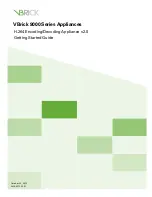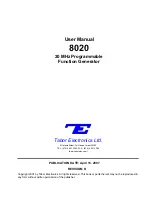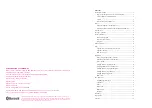
Non-Sound Decoder MX600 - MX634 and Sound Decoder MX640 - MX658 Page 21
CV
Designation
Range
Default Description
#49
Signal controlled
(HLU, ABC)
acceleration
0 - 255
0
Entered value multiplied by .4 equals acceleration time
in seconds from stop to full speed when:
“ZIMO signal controlled speed influence” with ZIMO
MX9 track section module and successors
or
“asymmetrical DCC signal” method (Lenz ABC) is em-
ployed
#50
Signal controlled
(HLU, ABC)
deceleration
0 - 255
0
Entered value multiplied by .4 equals deceleration time
in seconds from full speed to complete stop when:
“ZIMO signal controlled speed influence” with
ZIMO MX9 track section module and successors
or
“asymmetrical DCC signal” method (Lenz ABC) is em-
ployed.
#51
-
#55
Signal controlled
(HLU) speed limits
#51
#52 for “U” (Ultra low)
#53
#54 for “L” (Low speed)
#55
0 - 255
20
40 (U)
70
110 (L)
180
ZIMO “signal controlled speed influence” method (HLU)
using MX9 or successor:
Defines the internal speed steps for each of the 5
speed limits generated via HLU.
#59
Signal controlled
(HLU, ABC)
delay
0 - 255
5
ZIMO signal controlled speed influence (HLU) with
ZIMO MX9 track section module or future module
or
when using the “asymmetrical DCC signal” stopping
method (Lenz ABC):
Time in tenth of a second until the locomotive starts to
accelerate after receiving a higher signal controlled
speed limit command.
3.10
“Asymmetrical DCC-Signal” stops (Lenz ABC)
The “asymmetrical DCC signal” is an alternative method for stopping trains at a “red” signal. A simple
circuit made up of 4 or 5 commercially available diodes is all that is required.
3 to 5 silicon diodes in series and
one
Schottky diode in parallel in the op-
posite direction
is the usual arrange-
ment.The different voltage drops
across the diodes results in an asym-
metry of about 1 to 2V. The direction in
which the diodes are mounted deter-
mines the polarity of the asymmetry
and with it the driving direction a signal
stop is initiated.
The asymmetrical DCC signal stop mode needs to be activated in the decoder with CV #27. Normally
Bit 0 is set, that is CV #27 = 1, which results in the sam
e directional control as the “Gold” decoder
from Lenz.
The asymmetrical threshold (0.4V by default) can be modified with CV #134 if necessary (i.e. if the
DCC signal of a given command station is already offset to begin with). At the time of this writing, the
“asymmetrical DCC signal” has not been standardized and many DCC systems pay no attention to
this feature.
Note: the ABC slow speed supported by Lenz decoders (i.e. by the Lenz module BM2) is supported
by ZIMO decoders from SW-version 36.1.
CV
Designation
Range
Default Description
#27
Direction
dependent stops
with asymmetrical DCC
signal
(Lenz “ABC” method
0, 1, 2, 3
0
Bit 0 = 1: Stops are initiated if the voltage in the right
rail is higher than the left rail (in direction of
travel). This setting, CV #27 = 1, IS THE
COMMON APPLICTION for this feature (pro-
vided the decoder is wired to the rail correctly).
Bit 1 = 1: Stops are initiated if the voltage in the left rail
is higher than the right rail (in direction of
travel).
Stopping is directional if only one of the two bits is set
(not both). Traveling in the opposite direction will have
no effect. Use the other bit in case the train stops in the
wrong direction!
Bit 0 and Bit 1 = 1 (CV #27 = 3): Stops in both
directions, regardless of rail polarity.
#49,
#50
Acceleration-,
deceleration time
0 - 255
0
See chapter HLU.
#53
ABC slow speed
0 - 255
70
Internal speed steps for the ABC slow speed
#134
Asymmetrical
threshold
for
stopping with
asymmetrical DCC signal
(Lenz ABC method).
1 - 14,
101 - 114,
201 - 214
=
0,1 - 1,4 V
106
Hundreds digit: Sensitivity adjustment, improves the
asymmetric-recognition by changing the speed with
which the asymmetry is being recognized.
= 0: fast recognition (but higher risk of errors,
may lead to unreliable stopping).
= 1: normal recognition (@ 0.5 sec.), fairly
reliable (default).
= 2: slow recognition (@ 1 sec.), very reliable.
Tens and ones digit: Asymmetrical threshold in tenths
of a volt. The voltage difference between the two half
waves of the DCC signal defines the minimum required
to be recognized as asymmetrical that starts the in-
tended effect (usually braking and stopping of a train).
= 106 (Default) therefore means normal recognition at
0.6 V asymmetry. This value has proven itself to be ap-
propriate under normal conditions; by using 4 diodes to
generate the asymmetry.
#142
High-speed correction
for the ABC
asymmetrical stop
method
0 - 255
12
A delayed recognition (see CV #134), but also unrelia-
ble electrical contact between rails and wheels, have a
larger effect on a stop point at higher speeds than at
lower speeds. This effect is corrected with CV #142.
= 12: Default. This setting usually works fine with the
default setting in CV #134.
Stop section
Track power from
command station
Silicium diodes,
i.e. 1N5400x
(3 A - Types)
Main trac k
Trav el direc tion
Switc h to
c anc el s top
when s ignal
turns “green”
Note:3 diodes in s eries is
the minimum required to
s top ZIMO dec oders . 4 or
more diodes are s ometimes
needed for other dec oder
brands . Bec aus e the diodes
c aus e an undes ired v oltage
drop, us e the minimum
number of diodes pos s ible.
red
















































